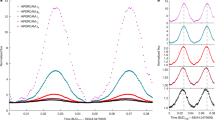Abstract
Boriakoff et al.1,2 have recently reported the discovery of a pulsar, PSR1953+29, with a pulse period, P, of only 6.1 ms, and with period derivative Ṗ<6 × 10−16 ss−1. This is only the second known pulsar with P in the millisecond range, the first being PSR1937 + 2143,4. PSR1953 + 29 is in a binary system with an unseen companion: its orbital period, Porb, is ∼120 days, its projected semi-major axis, ap sini, is ∼9 × 1011 cm, and its orbital eccentricity, e, is small. We present here a model for the origin and evolution of this binary system that quantitatively accounts for all of its salient features. Our evolutionary scenario begins with a luminous binary X-ray source (see also refs 17,18) composed of a neutron star and a lower giant-branch companion (we do not attempt to understand the preceding evolution, which may well have included a common-envelope phase5,6), and terminates when the system has evolved into its present configuration and the companion has become a low-mass degenerate dwarf. We show that our model can explain both the large separation of the binary and the approximate circularity of the orbit despite the large separation relative to the present sizes of the component stars (which tends to render inoperative the tidal dissipation that might otherwise circularize the orbit7,8).
This is a preview of subscription content, access via your institution
Access options
Subscribe to this journal
Receive 51 print issues and online access
$199.00 per year
only $3.90 per issue
Buy this article
- Purchase on Springer Link
- Instant access to full article PDF
Prices may be subject to local taxes which are calculated during checkout
Similar content being viewed by others
References
Boriakoff, V., Buccheri, R. & Fauci, F. IAU Circ. No.3806 (1983).
Boriakoff, V., Buccheri, R. & Fauci, F. Nature 304, 417–419 (1983).
Backer, D. C., Kulkarni, S. R., Heiles, C., Davis, M. M. & Goss, W. M. IAU Circ. No.3743 (1982).
Backer, D. C., Kulkarni, S. R., Heiles, C., Davis, M. M. & Goss, W. M. Nature 300, 615 (1982).
Paczyński, B. Structure and Evolution of Close Binary Systems, IAU Symp. No. 88, 75 (1976).
Meyer, F. & Meyer-Hofmeister, E. Astr. Astrophys. 78, 167 (1979).
Lecar, M., Wheeler, J. C. & McKee, C. F. Astrophys. J. 205, 556 (1976).
Zahn, J.-P. Astr. Astrophys. 57, 583 (1977); erratum 67, 162 (1978).
Taam, R. E. Astrophys. J. (in the press).
Webbink, R. F., Rappaport, S. & Savonije, G. J. Astrophys. J. (in the press).
Joss, P. C. & Rappaport, S. Nature 264, 219 (1976).
Joss, P. C., Avni, Y. & Rappaport, S. Astrophys. J. 221, 645 (1978).
Landau, L. D. & Lifshitz, E. M., The Classical Theory of Fields 2nd edn (Pergamon, Oxford, 1962).
Ruderman, M. A. & Shaham, J. Comments Astrophys. Space Sci. (submitted).
Manchester, R. N. & Taylor, J. H. Pulsars (Freeman, San Francisco, 1977).
Manchester, R. N. et al. Astrophys. J. 268, 832 (1983).
Alpar, M. A., Cheng, A. F., Ruderman, M. A. & Shaham, J. Nature 300, 728 (1982).
Fabian, A. C., Pringle, J. E., Verbunt, F. & Wade, R. A. Nature 301, 222 (1983).
Author information
Authors and Affiliations
Rights and permissions
About this article
Cite this article
Joss, P., Rappaport, S. On the origin of the 6.1-ms pulsar. Nature 304, 419–421 (1983). https://doi.org/10.1038/304419a0
Received:
Accepted:
Issue Date:
DOI: https://doi.org/10.1038/304419a0
This article is cited by
-
Magnetic Fields of Neutron Stars
Journal of Astrophysics and Astronomy (2017)
-
Formation of Double Neutron Stars, Millisecond Pulsars and Double Black Holes
Journal of Astrophysics and Astronomy (2017)
-
Scenarios for the formation of binary and millisecond pulsars – A critical assessment
Journal of Astrophysics and Astronomy (1995)
Comments
By submitting a comment you agree to abide by our Terms and Community Guidelines. If you find something abusive or that does not comply with our terms or guidelines please flag it as inappropriate.



